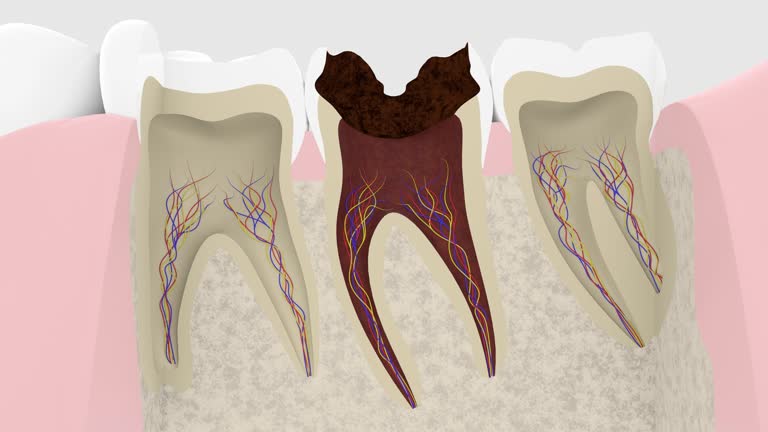Root canals are a common dental procedure designed to save a tooth that is deeply infected or decayed. While many people undergo successful root canal treatments, some experience complications leading to a failed root canal. If you’ve had a root canal that didn’t quite work out, you’re not alone. Understanding why root canals fail and knowing your options can help you make informed decisions about your oral health.
What Is a Root Canal and Why Is It Needed?
A root canal is a dental procedure used to treat infection within the pulp, or soft tissue, of a tooth. This infection typically occurs due to deep decay, trauma, or cracks that allow bacteria to enter the pulp. The procedure involves removing the infected pulp, cleaning the inside of the tooth, and sealing it to prevent further infection. A crown is often placed on top of the tooth for protection and to restore its function.
While root canals have a high success rate, failure can occur for a variety of reasons. It’s important to understand the potential causes of a failed root canal so that you can address the issue promptly and prevent further damage to your tooth and surrounding structures.
Causes of a Failed Root Canal
Incomplete Cleaning or Sealing
One of the most common causes of root canal failure is incomplete cleaning or sealing of the tooth. During the procedure, the dentist removes infected tissue from the pulp chamber and the root canals. However, if all the infected tissue is not fully cleaned out or if the canals aren’t sealed properly, bacteria can remain and cause reinfection. Sometimes, the complexity of the root canal anatomy makes it difficult to access every area, especially if there are tiny, curved, or hidden canals that were missed during treatment.
New Infection
Even if a root canal is initially successful, new infections can develop if the tooth isn’t properly sealed or if the tooth is subjected to trauma. This can allow bacteria to enter the tooth again, leading to reinfection. For instance, if a crown placed after the root canal isn’t sealed tightly, it can leave space for bacteria to get inside.
Cracks or Fractures in the Tooth
Teeth that have undergone root canal therapy can sometimes develop cracks or fractures. These cracks can allow bacteria to enter and cause an infection, leading to failure. This is particularly common if the tooth was structurally weakened by extensive decay or trauma before the root canal was performed.
Delayed or Inadequate Follow-Up Care
After a root canal, it’s essential to follow up with your dentist to ensure proper healing and monitor for any signs of infection or complications. If the tooth is not properly restored with a crown, or if there’s an issue with the crown or filling later, the tooth can become vulnerable to reinfection or further damage.
Poorly Performed Procedure
While rare, root canal failure can also be attributed to mistakes made during the procedure itself. If a dentist or endodontist doesn’t properly remove the infected tissue, clean the canals, or seal the tooth properly, the treatment may fail. Choosing an experienced, skilled dental professional can significantly reduce the risk of a poorly performed root canal.
Anatomical Complexity
Some teeth have complex root canal systems that can be difficult to clean and seal thoroughly. Molars, for example, often have multiple roots and canals that can vary in shape and size. These variations make it more challenging to fully clean and seal the tooth, increasing the risk of reinfection and root canal failure.
Signs of a Failed Root Canal
It can sometimes be difficult to tell if a root canal has failed, but there are a few signs to watch for:
- Pain or Discomfort: Persistent or recurring pain, especially when chewing or pressing on the tooth, is one of the most common signs of a failed root canal.
- Swelling or Tenderness: Swelling around the treated tooth, along with tenderness in the surrounding gums, can indicate an infection.
- Darkening of the Tooth: A tooth that becomes darker over time after a root canal may be a sign that the infection is still present.
- Abscess or Pimple on the Gums: An abscess is a pocket of pus that can form due to infection and may appear as a pimple on the gums near the treated tooth.
If you experience any of these symptoms, it’s important to consult your dentist promptly for an evaluation.
Solutions for Failed Root Canals
Retreatment
In many cases, the first step for addressing a failed root canal is to perform retreatment. This involves reopening the tooth, cleaning out the previous filling material, and removing any remaining infected tissue. The canals are then cleaned and resealed, and a new crown may be placed. Root canal retreatment is often successful, but it may not always be possible depending on the extent of the damage.
Apicoectomy (Surgical Root Canal)
If retreatment isn’t an option or doesn’t resolve the issue, an apicoectomy may be performed. This surgical procedure involves making a small incision in the gum to access the root tip and remove any infected tissue that is causing the problem. The root canal is then sealed at the tip, and the incision is closed. An apicoectomy can be a highly effective solution for persistent root canal issues.
Extraction and Replacement
If a tooth is extensively damaged or infected beyond the point of saving, the best option may be to extract the tooth and replace it with a dental implant or bridge. Although this is usually a last resort, it can effectively restore both the functionality and appearance of your smile. For those in Astoria seeking a permanent solution, full dental implants offer a reliable way to replace a missing or compromised tooth, ensuring a natural-looking and durable result.
In Conclusion
A failed root canal can be frustrating and concerning, but understanding the potential causes and available solutions is crucial for preserving your oral health. Regular dental checkups, prompt attention to symptoms, and working with an experienced dentist can help ensure the success of your treatment and prevent complications. If you’re facing a failed root canal, don’t hesitate to explore your options and take the necessary steps toward restoring your smile.


